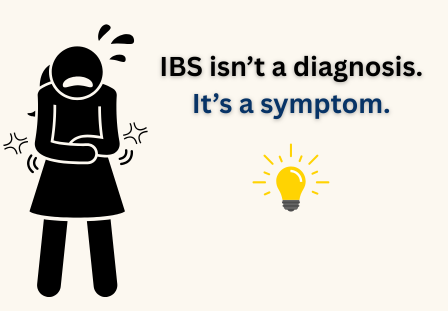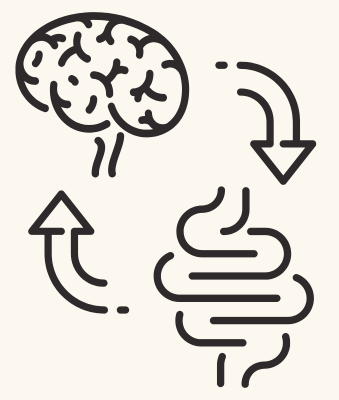The Misunderstanding Around IBS
Here’s what you’ll learn in this article:
-
Why IBS isn’t a diagnosis—but a symptom of deeper imbalance
-
How acupuncture restores gut–brain harmony when Western medicine can’t
-
Why it’s not just what you eat, but how you eat it that matters most
-
How to use Miridia Technology—AcuGraph, Lasers, and Jade Vitality—to identify and rebalance IBS energy patterns
-
Lifestyle medicine tips you can share with your patients for lasting gut health
Every week, practitioners around the world meet patients who sit across from them in quiet frustration, clutching a folder filled with lab results that say everything is “normal.”
They’ve been told they have Irritable Bowel Syndrome—and sent on their way with little more than dietary restrictions and stress management advice.
💡But here’s the truth: IBS isn’t a diagnosis. It’s a symptom.

It’s the body’s way of waving a red flag, signaling that the gut-brain connection has fallen out of harmony. It’s the physical manifestation of an overwhelmed system trying to communicate distress.
And this is where acupuncture—and Miridia Technology—shine. Because while Western medicine often focuses on symptom suppression, we focus on restoring regulation.
Hi, I’m Dr. Mackenzie Dawson Agnew, DACM, L.Ac. and in this article I’m going to show you how Acupuncture for IBS offers a powerful, holistic way to restore gut-brain harmony when Western medicine can’t find answers. I’ll also share some of my favorite clinical tools and laser acupuncture protocols, and explain how Traditional Chinese Medicine principles tie everything together.
Why IBS Is More Than a Gut Issue
IBS is never just about digestion. It’s about communication breakdowns—between organs, between meridians, and between the body and the mind.
It’s the story of a nervous system stuck in overdrive, of a Spleen struggling to transform food into Qi, and of a Liver that’s lost its rhythm.
When the Spleen and Stomach (the “post-heaven Qi” generators) fall out of sync, the entire energetic ecosystem falters.
Food stops being nourishment and becomes a source of inflammation, discomfort, and anxiety.
In Traditional Chinese Medicine (TCM), we don’t simply ask, “What food is causing your bloating?”
We ask, “Why can’t your body handle it today, when it handled it fine last month?”
Because often—it’s not the meal.
It’s the state of the nervous system when the meal was eaten.
🥣 It’s Not Just What You Eat — It’s How You Eat It

One of the most overlooked truths about digestion is that the gut only digests in safety.
When the nervous system is in fight-or-flight, blood leaves the digestive organs, stomach acid and enzyme production plummet, and peristalsis becomes chaotic.
In other words, you could eat the most perfectly balanced, organic, low-FODMAP meal—but if you’re anxious, multitasking, or eating in a rush—your body interprets it as a threat, not nourishment.
That’s why IBS is often less about food intolerance and more about nervous system intolerance.
As acupuncturists, we have the incredible ability to reset the system—to bring the body back into a parasympathetic, “rest-and-digest” mode where digestion can actually occur.
Using acupuncture, Jade Vitality, and Qi Lasers, we can stimulate vagal tone, slow the heart rate, deepen the breath, and reintroduce the gut to peace.
Once that shift happens, something beautiful follows:
The same meal that once caused cramping or urgency suddenly becomes digestible again.
The food didn’t change—the nervous system did.
📊 Using AcuGraph to Support Acupuncture for IBS Treatments

If IBS is a whisper from the gut, AcuGraph is the translation tool that turns that whisper into data.
In just a few minutes, AcuGraph maps out the body’s meridian energy flow, revealing where Qi is deficient, excessive, or imbalanced.
It takes what used to be “intuitive” for practitioners and makes it visible—a true blend of art and science.
Common AcuGraph Findings in IBS
• Spleen and Stomach Deficiency: sluggish digestion, fatigue, bloating after meals.
• Liver Excess: emotional stress, irritability, bowel urgency.
• Large Intestine Imbalance: alternating stool patterns, inflammation, dampness.
• Triple Energizer Instability: nervous system dysregulation and irregular bowel timing.
What makes AcuGraph remarkable is that it gives you—and your patient—a visual reference point.
When they see their imbalance on the screen, they understand the why behind their symptoms. And when they see the color changes after several treatments, they see healing in real time.
That kind of tangible progress transforms compliance into enthusiasm.
What is AcuGraph and how does it work?
AcuGraph helps acupuncturists attract and retain more patients by transforming energetic diagnosis into clear, visual, evidence-based insights your patients can instantly understand and trust.
“Okay,” you might be wondering, “So how does TCM (Traditional Chinese Medicine) fit in with acupuncture for IBS?
The Root of IBS in TCM
While every case is unique, most IBS presentations fall into a few common energetic stories:
Liver Overacting on Spleen
The classic “stress gut.” The patient who says, “It’s always worse on Mondays.”
The Liver’s stagnation spills into the Spleen, disrupting its ability to transform and transport.
-
Symptoms: bloating, cramping, alternating stool, sighing, irritability.
-
Treatment Focus: smooth Liver Qi, strengthen Spleen.
-
Key Points: LV3, LI4, ST36, SP6, Ren12, PC6.
Spleen Qi Deficiency
Overwork, poor diet, and worry weaken the digestive fire.
-
Symptoms: fatigue, poor appetite, bloating, loose stool.
-
Treatment Focus: tonify Spleen Qi, warm digestion.
-
Key Points: ST36, SP3, SP6, Ren12, Ren6.
-
Adjunct: Moxa or Jade Vitality Wrap for gentle heat therapy.
Damp-Heat in the Intestines
The patient who can’t be far from a bathroom.
-
Symptoms: urgency, foul odor, mucus in stool, acne, irritability.
-
Treatment Focus: clear heat, resolve dampness.
-
Key Points: ST25, ST37, LI11, SP9, Ren9.
Cold in the Intestines
The classic “cold belly” presentation.
-
Symptoms: pain relieved by warmth, watery stool, fatigue.
-
Treatment Focus: warm the middle, move Qi.
-
Key Points: Ren6, Ren8 (moxa), ST25, BL23.
The Miridia Approach: Blending Ancient Wisdom with Modern Technology
Miridia Technology’s tools are extensions of your hands—bridging the gap between traditional practice and modern precision. One of the easiest, and most effective tools you can start using today are the QiSeries Blue and Red Lasers!
🔵 QiCalm Blue Laser (450 nm)
The QiCalm Blue Laser delivers focused blue light at 450 nm, a wavelength known for its soothing, sedative, and anti-inflammatory effects.
It’s used to calm the nervous system, reduce intestinal inflammation, and gently restore parasympathetic tone—making it ideal for IBS cases linked to anxiety, overthinking, or chronic tension. The blue wavelength penetrates superficially yet profoundly influences meridian conductivity and the emotional centers of the body. It helps “quiet the mind and the gut” simultaneously.
Use QiCalm on:
• PC6 and Yintang – to calm the mind and promote vagal activation
• ST25 and Ren12 – to soothe intestinal spasms and harmonize digestion
• SP15 – to regulate peristalsis and relieve bloating
Patients often describe a deep sense of calm during treatment, as if their gut and nervous system finally exhale together.
🔴 QiPulse Red Laser (635 nm)
The QiPulse Red Laser operates at 635 nm, a wavelength that penetrates deeper tissue layers to stimulate circulation, cellular repair, and energy movement.
While QiCalm soothes, QiPulse energizes and strengthens—making it the perfect complement for IBS driven by Spleen Qi deficiency or sluggish digestion. This red wavelength promotes ATP production, microcirculation, and meridian flow, supporting the body’s natural ability to rebuild and regulate.
Use QiPulse On:
- ST36 and SP6 – to boost digestive fire and tonify Spleen Qi
- Ren6 – to strengthen Qi and warm the middle
- LI11 – to clear heat and harmonize bowel patterns
Used together, these lasers create a perfect yin–yang balance: calm and activation, regulation and restoration. They can bring the gut-brain axis back into harmony—where true healing begins.

🧠 The Gut–Brain Connection: Healing from the Top Down

The gut and the brain are in constant dialogue. When the brain perceives stress, the gut reacts—tightening, slowing, or over-activating.
When the gut is inflamed, it sends distress signals back to the brain, perpetuating anxiety and mood swings.
This bidirectional loop is the gut-brain axis, and it’s why treating IBS without addressing the nervous system rarely works.
Tools like CES Ultra and Qi Lasers act as gentle regulators, restoring coherence to this loop.
By calming the limbic system and balancing neurotransmitter release, they help the gut finally exhale.
🌸 Lifestyle Medicine for the IBS Patient
The beauty of acupuncture is that it doesn’t end when the needles come out.
We teach patients how to live in a way that supports their Spleen and respects their rhythm.
- Eat Warm, Eat Slow 🥘
Encourage patients to sit, breathe, and chew thoroughly.
Warm, cooked foods are medicine for the Spleen; cold smoothies and rushed meals are its undoing. - Hydrate Wisely 💧
Warm or room-temperature water keeps digestion active.
Cold drinks extinguish digestive fire—especially in chronic bloating or fatigue. - Create Calm 🧘♀️
Have patients take three slow breaths before meals, or place one hand on their abdomen and feel it rise as they exhale.
These simple rituals retrain the parasympathetic system and rewire digestive behavior. - Castor Oil + Jade Vitality ☯️
Castor oil packs are profoundly supportive for IBS. When combined with Jade Vitality’s gentle heat, they reduce inflammation, stimulate lymph flow, and soothe the gut wall—especially in cold-type or stagnation cases. Learn more here
Real-World Case Study: Rebalancing the Gut

Patient: 34-year-old woman, executive-level stress, alternating constipation and diarrhea, bloating, and anxiety.
AcuGraph Findings: Liver Excess, Spleen Deficiency, Large Intestine Deficiency, TE Instability.
Treatment:
• Acupuncture: LV3, LI4, ST36, SP6, Ren12, Yintang
• Qi Lasers: ST25, Ren6, SP15
• Jade Vitality + castor pack nightly
Outcome:
Within four weeks, bowel patterns normalized, bloating reduced by 80%, and stress scores dropped dramatically.
Follow-up AcuGraph showed restored Spleen Qi and balanced Liver flow.
She now returns monthly for maintenance—and her gut remains calm, even during work travel.
The Future of Treating IBS with Miridia Technology Tools
In a world where digestive issues are skyrocketing, acupuncturists have a unique opportunity to lead the conversation—not just about symptom relief, but root restoration.
Miridia Technology’s AcuGraph gives us the ability to track progress, visualize balance, and integrate modern tools with ancient wisdom.
When you combine acupuncture, Qi Lasers, CES, and patient education—you’re no longer just treating IBS.
You’re teaching the body to trust itself again.
IBS may be a common complaint, but with the right approach, it becomes one of the most rewarding conditions to treat. Because every time a patient’s gut finds peace, their entire life changes.
IBS may be the label, but imbalance is the reality. And balance—energetic, emotional, and physiological—is what we were born to restore.
About Dr. Mackenzie Dawson Agnew, DACM, L.Ac.
Dr. Mackenzie Dawson Agnew is a licensed acupuncturist and Doctor of Acupuncture and Chinese Medicine specializing in digestive health, hormonal balance, and women’s wellness. In her Canada-based practice, she blends modern tools like laser acupuncture, electroacupuncture, and meridian imaging with the wisdom of Traditional Chinese Medicine to help patients restore gut-brain harmony and overall balance.
Dr. Agnew also serves as a clinical educator and content contributor for Miridia Technology Inc., where she helps practitioners integrate technology with timeless acupuncture principles for better patient outcomes.
Learn more about Dr. Agnew’s work at Miridia Technology News
✅ Peer Review Acknowledgment
This article has been reviewed by fellow licensed practitioners for accuracy and clinical relevance:
Dr. Kimberly Thompson, DACM, L.Ac. and Dr. Adrian Larsen, D.C., C.Ac.
I wanted to like this article, and find an informed approach to treating IBS. But what it offered is a bunch of simplifications and cliches regarding a very complex syndrome. There is no mention of the immune system, or the microbiome. It is not merely a vagus nerve issue. That’s a great oversimplification, and it does not accurately qualify the issue or serve patients well. There are solutions out there, and many other clinical presentations that can be mistaken for IBS. So i would be wary of oversimplifying.
Thank you so much for your feedback, Yodee! I really appreciate you taking the time to share your perspective. This article wasn’t meant to be a full scholarly review of IBS, but rather a simple and accessible way to share some helpful insights from a Traditional Chinese Medicine and acupuncture lens. I completely agree that IBS is a multifaceted condition involving the gut, immune system, and nervous system-and I love that conversations like this open up space for deeper understanding from both Western and Eastern perspectives.